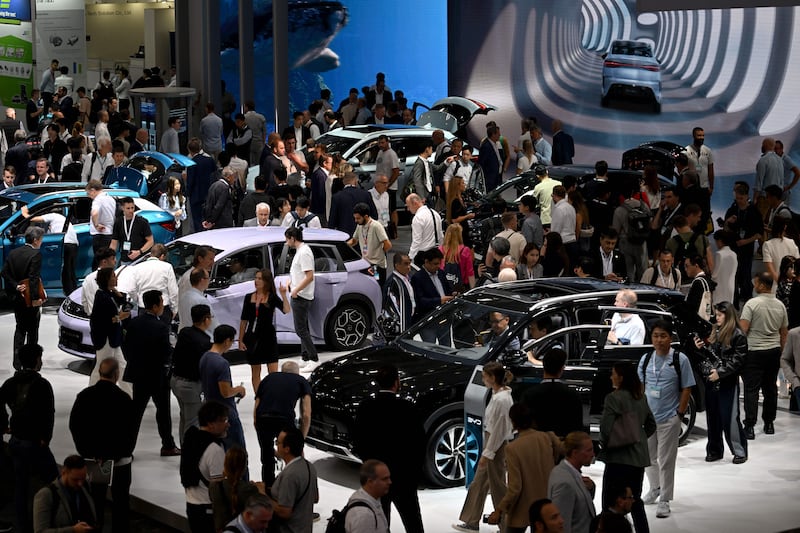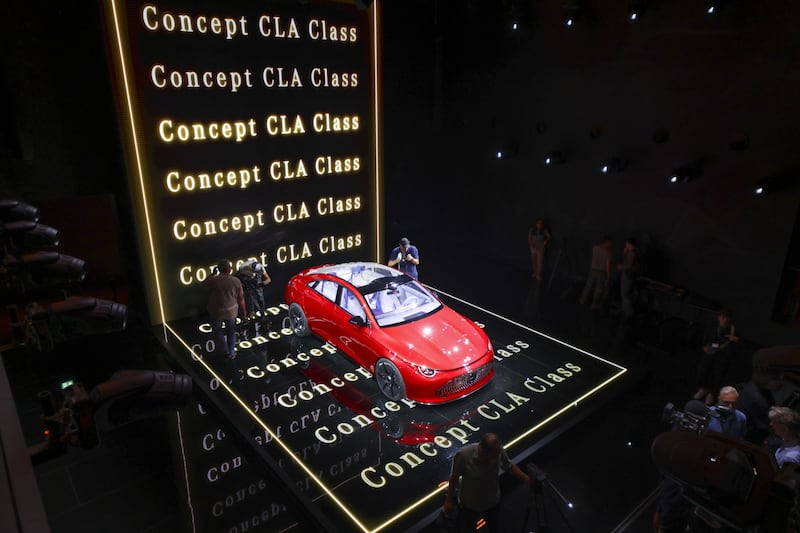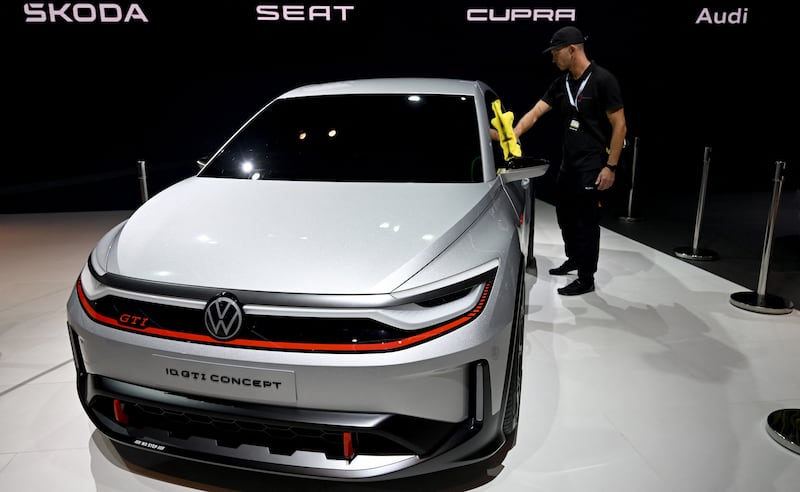Have motor shows suddenly become a thing again? We assumed that they’d all been killed off by the pandemic, but suddenly, the IAA motor show, which is in its second year of a move from Frankfurt to Munich, feels relevant again.
Certainly, there was a boisterous queue of car makers – and not just the expected German big-hitters – queuing up to show us new electric models boasting big ranges.
Actually, in the run-up to the show, Tesla showed off the much-anticipated major update to the Model 3 saloon. Quite aside from the relatively gentle physical changes inside and out, the Model 3 was boasting an improved range on one charge, reaching 672km in the updated Long Range version.
The fact that Tesla actually showed up to the show reinforced the idea that maybe this gathering in one place to look at new cars is an idea still with legs. Given the Model 3′s popularity and not least its price point, it felt significant that we were seeing a fairly affordable four-door family car touching the hem of a 700km range.
READ MORE
That, as it turned out, was only the starting bid.

BYD – the gigantic Chinese company which launched its products in Ireland for the first time this year, with the agreeable Atto 3 electric crossover and the rather more invigorating Seal EV saloon – was one of the first out of the blocks with its Seal U, an SUV based on the same platform and 82kWh battery as the Seal saloon, and boasting a 500km range (or 600km if you believe the official Chinese CLTC test) for its most expensive version. A year or two ago, that may have seemed impressive. By the time the IAA show was emptying out after the last of the media days, it was looking distinctly second rate.
BMW was next into the fray, with a car that could not be more important for the Munich-based brand. The Vision Neue Klasse is a name-play on the original Neue Klasse of the 1960s, a compact saloon that literally saved the company from an impending bankruptcy. No such danger this time around but BMW needs to put a stamp on this new electric era if it’s going to see of competition from the likes of Tesla and the encroaching Chinese brands.
The Vision Neue Klasse seems to do so almost effortlessly. It’s unquestionably the best-looking bit of BMW design in at least a decade, doing away with the ghastly gigantic grilles of current models, and reintroducing a shark-nosed, pert-tailed look that definitely harks back the late seventies and early eighties, as does its clean, simple, brightly-coloured interior.
It’s the batteries and the range that really score, though. BMW says that the Neue Klasse, which will go into production in 2025 with styling that’s broadly unchanged from what we saw on the stage in Munich, will use the company’s new sixth-generation cylindrical batteries. These are claimed to be able to deliver 30 per cent more range for a given capacity than current batteries, so assuming that the Neue Klasse launches with the same-sized 80kWh battery as the current i4, that should be a range of up to 750km on one charge. BMW is promising faster charging, too.

Dr Peter Lamp, one of BMW’s battery experts predicted to The Irish Times that by 2025 BMW would have a car on sale capable of at least 600km on one charge – he and his team seem to have excelled themselves. Certainly, BMW’s boss Oliver Zipse was bullish at Munich: “The BMW Vision Neue Klasse combines our ability to innovate in the core areas of electrification, digitalisation and circularity. In this way, we are always able to stay two steps ahead of the future: The Neue Klasse is already bringing the mobility of the next decade to the roads in 2025 – and leading BMW into a new era.”
Inevitably, Mercedes was not going to let that lie. Munich might be BMW’s home turf, but the boys from Stuttgart knew that they had something big up their sleeves. Well, actually something compact – the Concept CLA Class, a thinly-disguised concept version of the next-generation, electric, CLA. It’s not what you’d call a pretty car – the gaping grille and hooded lights at the front, all studded with Mercedes stars, make it look like some kind of angry aquatic gangster character from a Saturday morning cartoon.
What’s under the skin, though, is deadly serious. The Concept CLA is built around Mercedes’ new MMA (Mercedes Modular Architecture) platform, which will replace the NGCC (New Generation Compact Class) architecture that has give us new electric versions of the CLA, CLA Shooting Brake, EQA, and EQB.

To do that, the MMA gets a new battery. In fact, it gets two. Basic models of the production version of this Concept CLA will use a lithium-iron phosphate battery – a form of battery chemistry which is less energy dense than current lithium-ion designs, but which is cheaper by far to make, uses fewer rare Earth metals (cobalt, especially) and which is more robust and less temperature-sensitive than current designs.
More pricey models will get a lithium-ion battery with a silicon-oxide anode design which is said to be exceptionally energy-dense and efficient. Indeed, Mercedes reckons that its consumption of electricity will be as low as 12kWh/100km and that the top-spec version, with a likely battery capacity of around 90kWh, will be able to go 750km on one charge. Given how efficient the bigger EQE and EQS models are, we would be inclined to believe that claim.
Volkswagen’s big star of the show, the ID.GTI concept, based around the ID2.all concept car, isn’t massive on range – it’ll have around 400km when it launches in 2025 – but at least if it’s not competing with the long-range boys, it’s reminding them that fun still has a place in a charging-obsessed world.

We even got to see one outlandish concept car – Cupra’s arrowhead-shaped DarkRebel, although its debut was rather undercut by VW boss Thomas Schafer also confirming that Seat won’t replace its current line-up, and the brand will slowly be allowed to die off as a car maker (although it will continue as a micro-mobility brand).
Renault probably thought it was sitting pretty, with its roomy new electric Scenic, and its 620km range, but it just kinda showed how inefficient SUVs and crossovers are compared with low-slung saloons like the BMW, Mercedes, and Tesla.
The arrivals of the new all-electric Mini hatchback and Mini Countryman crossover were somewhat overshadowed by the big-brother BMW Neue Klasse, and by the fact that they weren’t coming in with particularly massive ranges (400km max for the hatch, 462km for the Countryman). Still, alongside the Minis, it was rather enormously refreshing to see a major motor show where the big stars weren’t actually enormous – they were mostly compact models, and the three most significant were saloons, not massive SUVs. Maybe that, and the fact that a motor show seems suddenly significant again, shows that the motoring world is finally healing?
Andreas Mindt, designer of that oh-so-desirable VW ID.GTI concept (which is headed for production) is in no doubt. How does it feel to debut your new car on a real motor show stage, with real crowds, The Irish Times asked Mindt?
“Honestly, it feels like I am 12 years old again” he replied. “It’s amazing. It’s like a gift, I just love it. I think car shows are back, yes. It was so crowded today, so interesting. So good to talk to people, eye-to-eye, that’s amazing. I love it, the connection with other people is great. So let’s do it, let’s bring motor shows back.”












